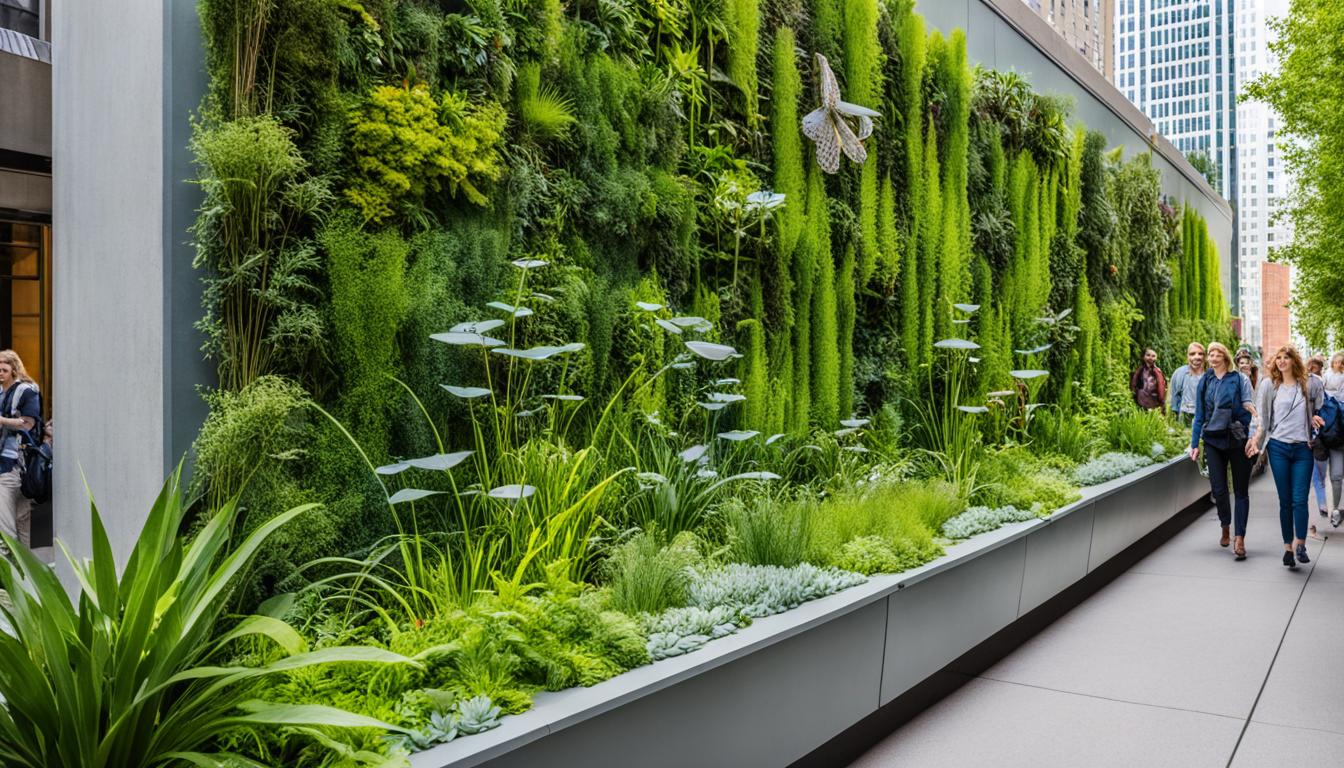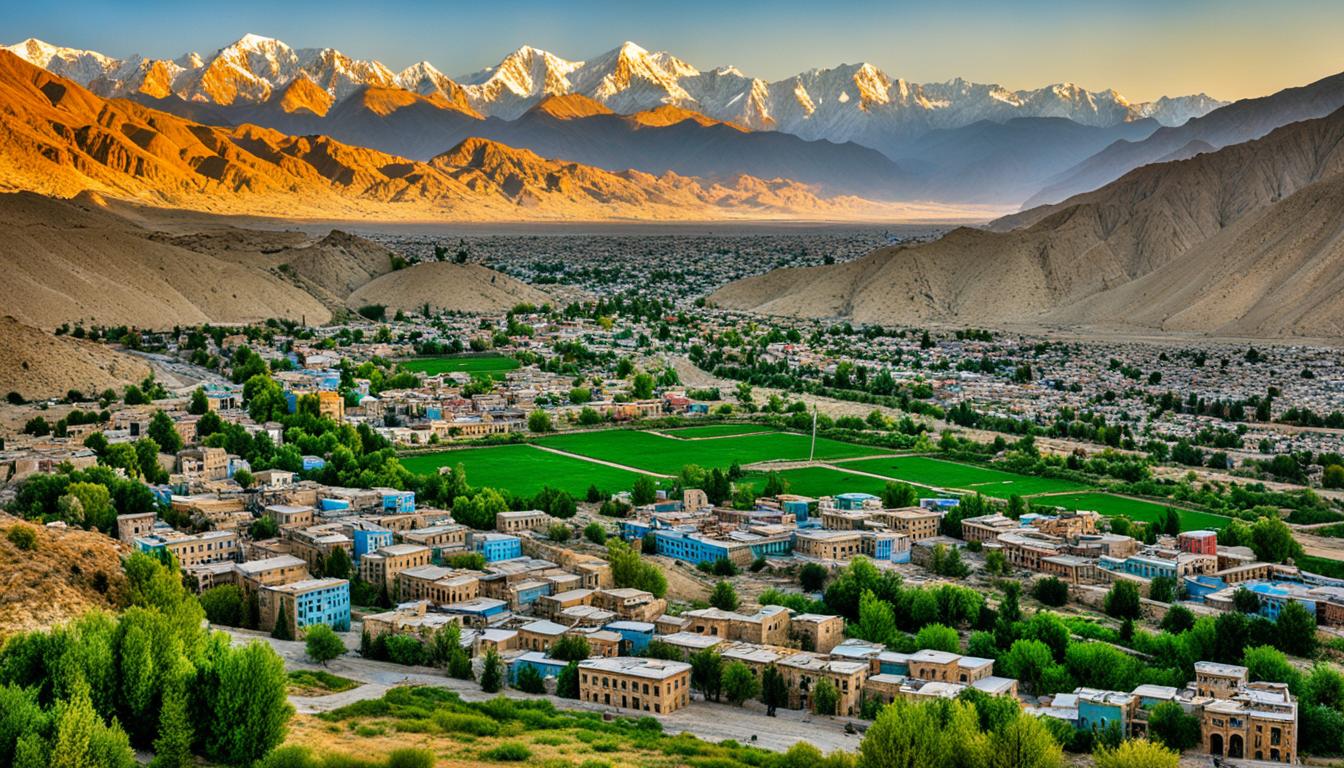Building for Nature: The Future of Biodiversity-Friendly Architecture
Amazingly, we are at risk of losing over 1 million plant and animal species. This is because of what humans are doing on our planet. Luckily, the design industry is stepping up. It’s moving towards creating buildings that help the environment. We call this nature-positive architecture. It focuses on the good that buildings can do for wildlife and the natural world.
Our actions have hurt Earth’s biodiversity. But, clever design can turn things around. It can make homes for animals, clean the air, and lower harmful gases. This type of architecture brings lots of good. It makes our living spaces fit in better with nature. This way, we can live in a way that looks after our planet.
Key Takeaways
- The design industry is trending towards “nature-positive buildings” that prioritise environmental sustainability and enhance biodiversity.
- Nature-positive architecture considers the ecological impact of structures and aims to create buildings that work in harmony with nature.
- Biodiversity-friendly architecture can create habitats for wildlife, improve air quality, and reduce carbon emissions.
- Biodiversity-friendly architecture promotes a sustainable and healthy coexistence between human-made structures and the natural environment.
- Architects have a crucial role to play in biodiversity conservation through their design choices.
The Importance of Biodiversity for Sustainability
Biodiversity means the countless forms of life on Earth. Each living thing, from tiny bugs to huge trees, helps keep our world ticking. They clean the air we breathe, the water we drink, and make sure our environment stays comfortable for us.
Understanding Biodiversity and its Benefits
Biodiversity shows us the many different plants, animals, and more. All these pieces fit together to form life’s complex puzzle. Protecting this variety is essential. It ensures we have what we need for our health and a good life.
The Role of Architecture in Biodiversity Conservation
Our cities are growing, and so is our need to protect nature. This is where architects come in. They can design spaces that actually help plants and animals thrive.
By using friendly design choices, they turn buildings and parks into homes for wildlife. This work is key for our future, making sure our world stays full of life.

Architectural Strategies for Promoting Biodiversity
Architects are key in helping save biodiversity with their design choices. They add green roofs and living walls. They also create wildlife habitats and use sustainable materials. These choices greatly help the local plants and animals.
Green Roofs and Living Walls
Green roofs and living walls are unique design elements. They give homes to many plants and animals. They fight city heat and clean the air. Plus, they make the area better for local biodiversity.
Wildlife Habitats in Building Design
Building designs can include birdhouses and bat boxes. This simple step boosts the habitat for local animals. It provides a safe place for them to live and breed. This helps keep the local biodiversity thriving.
Sustainable Material Choices and Construction Practices
Choosing sustainable materials and green building practices helps too. Architects should aim to use less, recycle, and go for eco-friendly options. This makes their work better for the planet. It supports ecological construction and enhances biodiversity.

The Impact of Architecture on Local Ecosystems
Architects have a big role in the health of our local ecosystems. Their work can change how water flows, disturb where animals move, and cut up their living spaces. These changes may reduce the numbers of native plants and animals in an area.
Changes to Natural Drainage Patterns
When we build, we create surfaces that water can’t soak into, like roads. This means water doesn’t naturally go where it should, carrying harmful things with it. To help, architects can include special ground, gardens and other green ideas that let water through. These help keep the ecosystem in balance.
Disruption of Migration Patterns
Animals need safe paths to travel between their homes. But, our buildings can block these paths, cutting them off from food and family. To fix this, architects design special passages that allow animals to move freely under or over our roads and buildings. This keeps their homes connected.
Habitat Fragmentation
Our constructions sometimes cut up wildlife areas into smaller parts. This splitting harms the animals that live there. Architects can protect these spaces. They keep important areas unbroken and add places for nature to flourish in their designs.

Architects can make a huge difference by looking ahead at what their designs might do to the area. They can take action so that nature stays intact and even thrives. Their thoughtful planning doesn’t just help the animals and plants but also makes our world a better place for everyone, now and in the future.
Incorporating Biodiversity in Urban Architecture
Urban areas often have less urban biodiversity because of all the hard surfaces and fewer green spaces. Yet, architecture can really boost biodiversity in cities. It can do this through nature-positive design.
Green Roofs and Living Walls in Urban Environments
Green roofs and living walls are great for birds, insects, and other small creatures. They also make the air cleaner and cut down energy use. These green designs make urban places more lively and welcoming to nature.
Integrating Wildlife Habitats into Building Designs
Adding birdhouses and bat boxes to buildings gives local wildlife homes. This biophilic design helps urban biodiversity grow. It makes people and nature live together better.
Maximising Natural Light and Ventilation
Getting more natural light and air flow makes cities healthier and more sustainable. Passive design uses the sun and wind to save energy. It makes places nicer for both people and wildlife.
Future of Biodiversity-Friendly Architecture
The future looks bright for biodiversity-friendly architecture. There are already amazing projects worldwide that blend design with nature. These projects lead us towards a green and biodiverse future.
Innovative Examples of Nature-Positive Urban Architecture
In Milan, Italy, the Bosco Verticale stands out. It has over 900 trees and 2000 plants, becoming a vertical forest. This brings biodiversity and lowers air pollution. In Osaka, Japan, the Namba Parks is a leader too. It has rooftop gardens and terraces that help local animals thrive.

These projects show us the power of nature-positive design. They include biodiversity-friendly features in cities. This makes our world more environmentally friendly.
The Challenges of Biodiversity-Friendly Design
Creating buildings that support nature is tough. First, architects and developers check the area’s plant and animal life. They also look at the soil, water, and more. This helps them see how their design might affect the area’s ecosystem.
Yet, understanding these impacts is not easy. It needs experts and new tools like Biodiversity Metric 3.1. Solving these issues is key to the project’s success.
Conducting Biodiversity Assessments
Before starting a bio-friendly project, they examine the place’s nature. They learn about the plants, animals, and the environment. This base info is crucial to see how the design changes the ecosystem over time.
Measuring and Monitoring Biodiversity Impacts
Figuring out the effects of a design on nature is hard. Tools like Biodiversity Metric 3.1 help, but you need experts. Overcoming these challenges is important for the project’s benefits in the long run.
| Biodiversity-Friendly Design Challenges | Description |
|---|---|
| Baseline Assessments | Looking at the site’s nature and biodiversity in detail |
| Biodiversity Metrics | Using special tools like Biodiversity Metric 3.1 to check effects |
| Monitoring and Evaluation | Watching how the environment and nature change because of the design |
| Ecological Complexity | It’s hard to accurately measure how architecture affects biodiversity |

Collaborating with Experts and Communities
Creating biodiversity-friendly buildings needs an
interdisciplinary collaboration
with a mix of professionals. This includes
biodiversity consultants
and
ecologists
. They offer key advice on how to check biodiversity, pick good ways to help local nature, and watch how the design affects things over time.
The Role of Biodiversity Consultants and Ecologists
Biodiversity experts and ecologists are key in making biodiversity-friendly architecture. They help architects know about the plants and animals in an area. This info lets designers make plans that fit well with the local ecosystem. They also help select native plant species and add things like wildlife areas, green roofs, and living walls. These all help support and grow local biodiversity.
Engaging with Local Communities and Stakeholders
Talking to local communities and stakeholders is really important too. It’s key for building successful biodiversity-friendly buildings. By getting feedback from the people involved, architects ensure the plan meets local community’s needs and wishes. This co-creative design process is also great for making people feel they own and take care of the area. It encourages them to stay involved in looking after the biodiversity-friendly features for a long time.

The Economic Benefits of Biodiversity-Friendly Architecture
Choosing biodiversity-friendly designs can offer economic benefits to those in the building sector. Some developers see how adding biodiversity features not only cuts environmental risks but also boosts the appeal and value of their sites.
Many governments now support biodiversity-friendly design. For example, Singapore helps cover half the costs of green roofs and walls. This kind of support makes it more profitable for builders. It also helps lower environmental risks and related costs, like handling stormwater and fighting urban heat islands. These benefits lead to long-term savings and encourage sustainable choices.
With more attention on biodiversity, the economic case for nature-friendly architecture is getting stronger. This trend makes it more interesting for both investors and the general public.

Conclusion
The future of biodiversity-friendly architecture looks bright, offering a chance to build environments that are more sustainable and ecologically-conscious. With features like green roofs and wildlife areas, architects can fight against biodiversity loss. They can make human structures work better with nature.
There are some tough parts too, like figuring out how well we’re doing in helping biodiversity. Yet, the positive effects on the environment, society, and the economy are huge. This makes it really important for designers. New ways to use nature in urban architecture are popping up. This shows that architecture can take a big role in helping the planet and being sustainable.
This story’s main points are the value of biodiversity-friendly architecture. It talks about ways architects can help diversity of life and the good sides of doing so. As we move forward, the design world’s focus on making architecture that loves nature will be key. It’ll help us live in a world that’s better for us and the planet.








